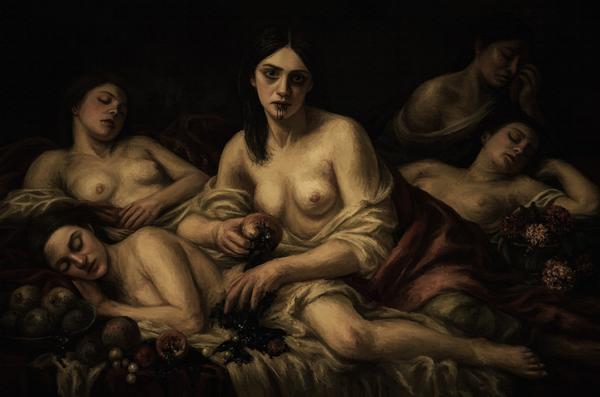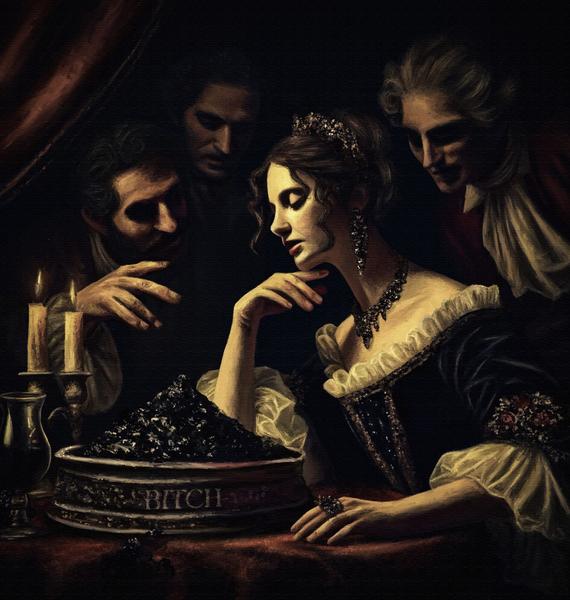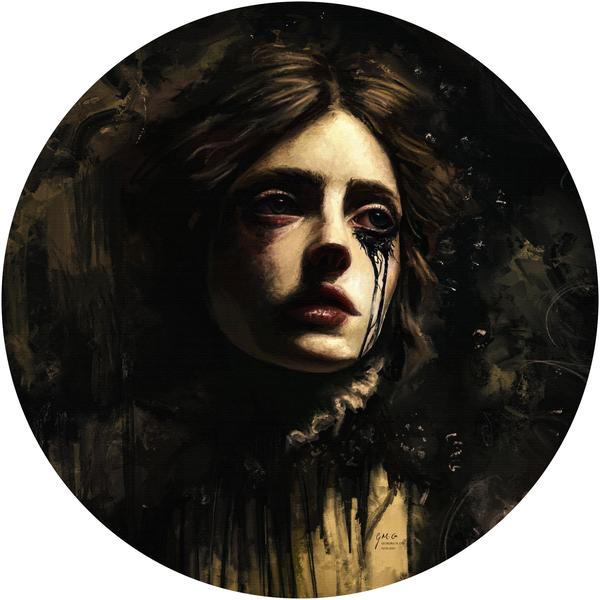

Total
CheckoutShipping & taxes calculated at checkout
Taxes calculated at checkout
Shipping calculated at checkout
Damnation is a series of digital paintings that reimagine Baroque and Romanticist aesthetics through a contemporary feminist lens. The project explores themes of sin, shame, power, and perception — centering around the ways women are watched, judged, worshipped, and devoured.
Each piece is painterly and theatrical, mimicking oil-on-canvas texture while incorporating modern symbolism and psychological horror. Black sludge, faceless saints, fragmented bodies, and corrupted rituals recur throughout the series. Some works are confrontational. Others are intimate and eerie — always asking the viewer to look closer, and question what they’re complicit in.
This project is as much about beauty as it is about discomfort. Damnation doesn’t just illustrate horror — it implicates you in it.
Dated: 2024-25
Meat for the Gods is a 180 x 115 cm digital painting printed on Portobello canvas. A grand horizontal tableau inspired by Baroque banquet scenes and sacrificial rites, the work depicts a group of reclining women — lush, bruised, and offered like fruit. Their expressions range from ecstasy to absence, from performance to detachment.
This piece interrogates the aesthetics of divine femininity and the consumption of the body as both spectacle and service. Drawing from religious mythology, vanitas symbolism, and Romanticist light, the painting becomes an altar — and the women, the offering.
Central to the Damnation series, Meat for the Gods stages beauty as a currency, and sacrifice as performance. It’s not about consent. It’s about survival.
Growing Pains is a 30 x 30 cm digital painting printed on wood, depicting a hunched, female form caught in the midst of transformation. Tendrils — hair? nerves? roots? — burst from her back, writhing with both horror and vitality.
This piece explores the unseen cost of growth. Of becoming something more, something terrifying, something powerful — and the pain it demands. It’s a portrait of discomfort as metamorphosis.
Inspired by Baroque lighting and mythic metamorphosis, Growing Pains is part of the Damnation series. It sits at the threshold between suffering and strength — a visual testimony to the agony of blooming.
Leak is a 30 x 30 cm digital painting printed on wood. The piece captures a woman mid-transformation — or mid-confession — as thick black liquid pours from her mouth and down her chest. Her eyes are wide, her body still, her silence broken by something unstoppable.
This painting explores repression, trauma, and the uncontainable force of truth. The figure is not in control — but she’s also not a victim. The act of leaking becomes both curse and catharsis.
Part of the Damnation series, Leak is painted digitally to mimic the texture and drama of oil portraiture, pairing baroque aesthetics with contemporary horror.
Preburn is a 30 x 30 cm digital painting printed on wood. The scene captures the moment just before execution — a young woman bound and prepared, surrounded by torchlight and onlookers. She does not cry. She does not fight. The tragedy is already decided.
This piece interrogates historical violence against women, the spectacle of punishment, and the ritualistic beauty often used to mask brutality. Drawing from Baroque lighting and martyr portraiture, Preburn confronts the aesthetics of sacrifice and the quiet horror of complicity.
A central work in the Damnation series, it is less about fire — and more about the stillness that lets it happen.
Think Pretty Thoughts is a 30 x 30 cm digital painting printed on wood. Echoing Romanticist portraiture and vanitas still life, this piece explores the quiet grotesque of beauty, obedience, and the subtle violence of being watched.
The central figure wears a white bridal dress and bows her head gently. But her skull is cut open like a cracked porcelain bowl, revealing a surreal bouquet of flowers, maggots, and pearls spilling from within. A shadowed male figure looms behind her, holding a sludge-drenched knife to her neck. Below, another opened skull rests — echoing hers — filled with the same sickly bounty.
This is not a scene of death, but of performance. Of being beautiful and good while rotting inside. Of swallowing the knife and smiling for the audience.
Part of the Damnation series, this painting turns femininity into a theatre of quiet horror — lush, mournful, and intimately cruel.
Communion of the Damned is a digital painting that stages a ritual of submission, hunger, and sacrificial performance. A central figure stands solemn and leaking, as a ring of identical women surround her — partaking, praying, pleading.
Inspired by religious iconography, Baroque banquet scenes, and horror cinema, this piece explores the consumption of one woman for the comfort of many. It is about collective silence, coerced sanctity, and the kind of communion that leaves nothing behind.
Printed at scale to mimic altarpiece dimensions, this work anchors the Damnation series in its fullest form — where femininity is no longer simply seen, but devoured.
What Did You Expect? is a digital painting that plays with visual seduction, performance, and retaliation. Echoing the lighting and posture of Baroque portraiture, the figure appears delicate and composed — until the black sludge begins to drip from her fingers.
This piece is about expectation: how femininity is demanded, shaped, and then punished for becoming something darker than desired. She is not crying. She is not broken. She is looking straight at you.
Part of the Damnation series, this painting examines the soft cruelty of being watched, the slow burn of being underestimated, and the quiet satisfaction of finally turning rotten.
We Must Not Speak of It is a digital painting exploring enforced silence, collective complicity, and the weight of what’s unspoken. Multiple women mirror each other — hands over mouths, black sludge seeping between their fingers, their eyes full of knowing.
The repetition makes the image feel ritualistic, almost sacred. But this is no holy vow — it is a curse passed down, a lesson taught in shame and reinforced through fear.
Rendered in painterly digital textures that mimic oil, this piece belongs to the Damnation series — an ongoing visual reckoning with femininity, power, and pain that lingers beneath the surface
She Was the First to See is a digital painting capturing a quiet moment of haunting foresight. The figure is young, solemn, and resolute — with dark tears trailing down her cheeks like inked prophecy.
This work explores the loneliness of knowing. Of being right too early. Of carrying truth when others aren’t ready to face it. Inspired by Romantic portraiture and ghost story aesthetics, it’s less about the horror itself — and more about the moment just before it begins.
Part of the Damnation series, the piece mimics oil through digital texture and chiaroscuro light, holding the viewer in an intimate, accusatory gaze.
Predation is a 25 x 25 cm digital painting printed on wood. A tangle of wolves, crows, snakes, lions and human bodies twists together in an almost religious tableau — a dark, symbolic portrayal of hunger, power, and submission.
This piece explores themes of consumption, objectification, and the thin line between desire and destruction. It’s not a literal scene — it’s a metaphor for how women are often both feared and fed upon, praised and punished. The central figure is buried in mouths and myths.
Rendered in a painterly Baroque style, Predation is part of the Damnation series — an ongoing visual interrogation of femininity, horror, and divine spectacle.
Tenebris Solis (Darkness of the Sun) is a 25 x 25 cm digital painting printed on wood. Fusing celestial iconography with Baroque light and Romantic emotion, the piece captures the intimacy of ruin — the moment after faith collapses.
A veiled figure cradles a darkened sun, its face both divine and wounded. Her expression is not regretful, but reverent — a grief that refuses to let go. This work explores themes of loss, spiritual disillusionment, and the eroticism of destruction.
Part of the Damnation series, Tenebris Solis is a small-scale relic of cosmic heartbreak.
Snail is a 14 x 10 cm digital painting printed on wood. It is one of the smallest pieces in the Damnation series — a quiet portrait of burden, transformation, and survival through stillness.
The figure is fused with the shell of a snail, hunched and heavy, retreating into herself. The grotesque hybrid becomes a metaphor for emotional labour, bodily weight, and the silent performance of softness under pressure.
Painted digitally to mimic oil, the piece uses warm brown tones and dramatic chiaroscuro to evoke a sense of still life and sacred relic. Snail is not loud, but it lingers.
Dinner For the Dog is a 30 x 31.6 cm digital painting printed on wood. Combining Baroque banquet staging with feminist horror, this piece explores the ritual of performance — particularly how women are often consumed before they are ever truly seen.
The central figure sits poised at the table, the centrepiece of a grotesque feast. Around her: leering men, hungry eyes, and a dish that may as well be her own body. The painting critiques objectification, social obedience, and the theatre of civility that often masks violence.
Part of the Damnation series, this work mimics oil painting in texture and depth while using digital tools to create a scene that feels timeless, tragic, and disgustingly familiar.
Deliver Us From Ourselves is a 60.5 x 50 cm digital painting printed on gold brushed aluminium. The reflective surface adds a sacred sheen — like a reliquary gone wrong — while the imagery splinters the very idea of holiness.
Multiple faces emerge from one body, caught in a swirl of robes, rituals, and writhing hands. Are they saints? Sinners? All or none. This work explores fractured identity, collective guilt, and the terrifying idea that sometimes the thing we need saving from… is us.
Part of the Damnation series, this piece draws from religious painting, Byzantine iconography, and horror cinema to interrogate selfhood, sin, and spiritual collapse.
Serve The Man is a 20 x 21.4 cm digital painting printed on wood — a twisted homage to both Baroque still life and biblical martyrdom.
The figure, regal and composed, presents a man’s head on a platter. She doesn’t gloat. She doesn’t weep. She simply performs — as women have always been expected to. This piece critiques obedience, patriarchal expectation, and the long tradition of women forced to play both saint and servant.
Inspired by religious iconography and art historical tropes, Serve The Man plays with viewer perception and symbolic inversion. The result is at once horrifying and absurd, intimate and political.
Part of the Damnation series.
Cattle is a 140 x 80 cm digital painting printed on Half Panama fabric — a soft, matte cotton blend that echoes historical banners or wall hangings. The scale and surface texture enhance the work’s unsettling stillness and make the viewer feel physically implicated.
The central figure is surrounded by dozens of near-identical women, each passive, each haunting. There’s no violence, no overt threat — only the horror of obedience, of being watched, of being part of something you cannot leave.
Inspired by themes of conformity, silence, and performance, Cattle is part of the Damnation series. It explores the collective performance of femininity and the ways in which the body becomes spectacle, standard, and sacrifice.
The Slaying of the Incubi is the final panel in the Incubus Incursion triptych — the climax and consequence.
No longer passive, the central figure now becomes the force of reckoning. The incubi, once entwined and overwhelming, are thrown into violent undoing. Wings fracture. Bodies fall. Her hand does not hesitate.
This 40 x 40 cm digital painting draws from Baroque battle scenes and religious martyrdom — but here, the saviour is herself. It is not a return to purity. It is a claiming of power through fire, wrath, and broken divinity.
Printed on wood, this panel concludes a narrative that began with a whisper and ends in myth. A holy vengeance made visible.
The Grasp of Perdition is the second panel in the Incubus Incursion triptych — the moment of full descent.
The once-still body is now ensnared. Writhing limbs, divine hands, and black tendrils wrap around the central figure in a composition that echoes Baroque depictions of martyrdom, ecstasy, and damnation. Here, the whisper has taken form. It touches not just skin, but self.
The piece examines spiritual trespass and erotic horror — how beauty can be weaponised, and how obedience is often demanded through softness.
40 x 40 cm, digitally painted and printed on wood for its icon-like tactility. Part of the Damnation series, this panel mirrors historical depictions of divine rapture, reimagined as something far more violating.
The Whisper is the first panel in the Incubus Incursion triptych — a narrative sequence exploring violation, illusion, and feminine perception within a mythological framework.
In this piece, a woman is caught in a moment of divine stillness. A whisper reaches her — gentle, almost holy — but beneath the beauty, something unnatural stirs. The angels look too closely. The light is too soft. The silence is suspicious.
This 40 x 40 cm digital painting is printed on wood to enhance its painterly illusion and icon-like weight. The piece draws heavily from Baroque composition and chiaroscuro light, designed to echo historical devotional panels — while the content quietly fractures the sanctity they promise.
The Whisper sets the tone for what follows: a slow undoing.
The Weeper is a 20 x 20 cm digital painting printed on a circular wooden panel. Inspired by religious iconography, mourning portraits, and Romanticist oil techniques, this piece explores grief as something held — quiet, unresolved, and holy.
Her gaze doesn’t seek pity. It indicts. The tears streak like brushstrokes, caught somewhere between realism and ruin.
Part of the Damnation series, this work blends classical portraiture with contemporary themes of emotion, vulnerability, and feminine silence. The circular format reinforces its stillness — a relic of sorrow preserved.
The Offspring II continues the exploration of maternal imagery introduced in The Offspring I — but here, tenderness slips into terror. The figure holds her creation with reverence, even as its form twists into something other, something sharp.
This piece examines themes of identity, transformation, and the unsettling closeness between nurture and destruction. Is she protecting it, or restraining it? Is she proud — or afraid?
Printed on birch wood at 20 x 30 cm, this digital painting mimics traditional oil work through chiaroscuro lighting, rich textures, and symbolic composition. Part of the Damnation project.
The Offspring I is a 20 x 30 cm digital painting printed on birch wood. Inspired by sacred portraiture and anatomical illustration, the piece explores motherhood, embodiment, and the quiet horror of transformation.
The figure appears serene, but something shifts beneath her hands — as if what she carries isn’t entirely hers. This piece reflects themes of inheritance, identity, and the thin veil between creation and possession.
Part of the Damnation series, The Offspring I uses painterly texture and chiaroscuro light to mimic oil painting while remaining fully digital — blurring the line between medium and message.
The Sin Eater is a digital painting created in the style of 17th-century oil portraiture. It reimagines the ancient folk role of a “sin eater” — a person paid to ritually consume the sins of the dead — as a woman cursed with divine appetite.
Her mouth is full. Her hands are mucky. She does not get to rest.
This piece is part of the Damnation series, a body of work exploring the intersections of feminine rage, sanctity, silence, and moral spectacle. As with much of the project, the work mimics oil painting while playing with illusion and perception — asking the viewer not just to look, but to witness.



